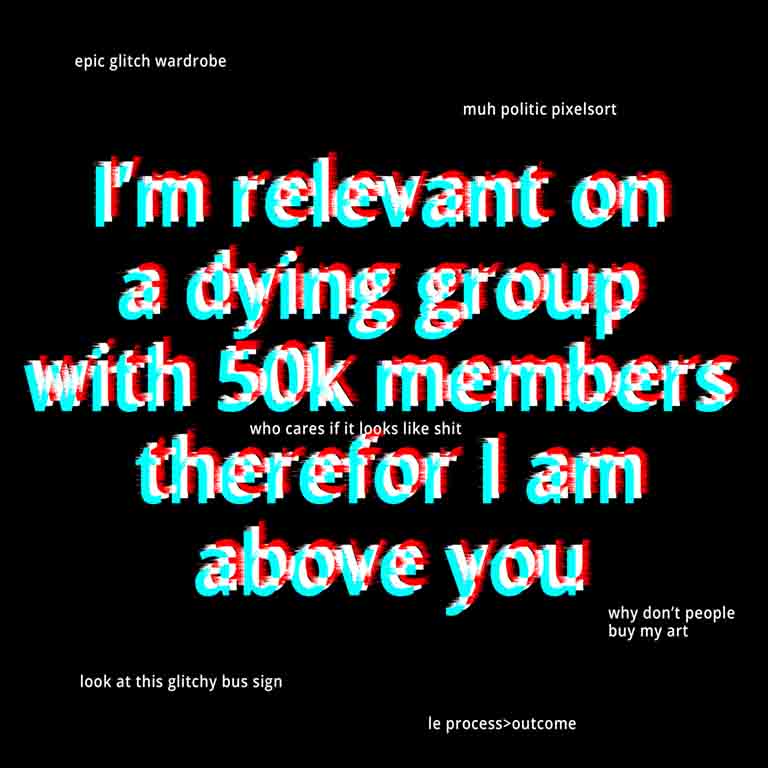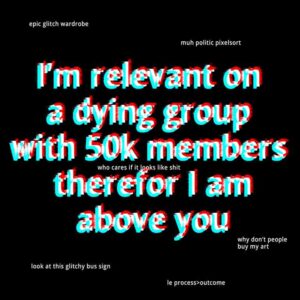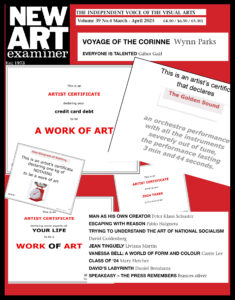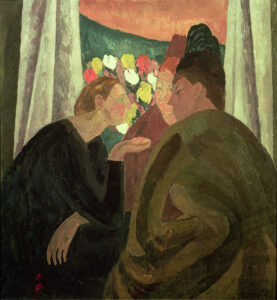
Fuck Gac
As circumstance breeds response so computers and the Internet bred glitch or as Jon.Cates of SAIC would call it ‘Dirty New Media’. In an increasingly computerized and data-centric society it would seem inevitable that the fetishization of error as a response to technology and its colonization of both our public and private lives is the new art.

If the gallery is the screen and the screen is everywhere , where can I go to find it and how do I make it ?
Mathieu St Pierre started the Facebook group ‘Glitch artists collective’ , some five years ago, in conversation with him I asked why ? “ Back in 2012, I felt that most groups already existing (on Facebook and Flickr) were very generic and didn’t have much of an identity except asking people to post random glitched images/videos. So I thought it would be great to create a group that has a sense community, hence the “collective” within the name. Since most art movements always had a specific location/city where they evolve, I think it’s important to understand the roots of glitch art which are mainly driven from Internet culture. It’s a global movement that went viral and I believe GAC resonates with that. It’s only recently that you can see artists actually calling themselves “glitch artists”, so it’s slowly taking shape and becoming recognized by the art world.”
Glitch arts currency is reputation , likes and novelty – it may not last longer than your flicking through it , you may have just made it on your smartphone with an app like Glitche or crunched through a bash script on your desktop, it could be a shot of an electronic noticeboard in the throes of software meltdown on your commute home.
Go there and look for the work of Enad Yenrac, Kaspar Ravel , Pandy Chan, Sarah Zucker and Zoe Stawska then look at the work of Tomaz sulej on codecs, specifically Glic , and the tool time counterpart of Gac.
Glitch art makes its own tools through coding or the misuse of programs and hardware, the price of entry is access and a willingness to break stuff . There’s an underground of circuit bending exemplified by the work of collectives like Cracked Ray Tube who deal in re-purposing old TVs and making installations with them ( and also making guides for beginners ) or the work of Philip Stearns and his ‘year of the glitch’ which involves circuit bending digital cameras and making fabric from the resulting images . Circuit bending can be traced back to the work of Reed Ghazala, his work, though audio based, can be equally applied to that of video as seen in the work of LZX industries and the Facebook group Video Circuits .
It also has a level of self criticism , ‘ Wheres the glitch fam’ is used when work is just simple photo-shop filter fests or after effects laziness , in a recent post to GAC Nick Yasa posted the image above which pokes fun at the laziness and self absorption of some of the posters – titled ‘Fuck gac’ – although the cost of admission is free it requires you at least make the effort . But then as Rosa Menkman says ‘Glitch art is dead’.
Ian Keaveny, Ireland
Volume 32 no.2 November/December 2017 p32

